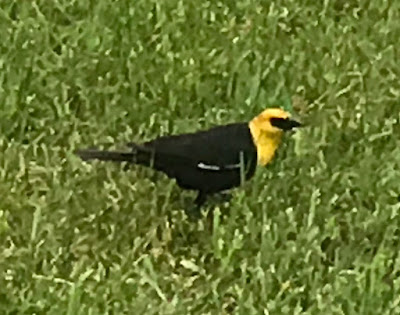 |
| The wetland area in front of St. John's. |
I enjoyed many beautiful late-summer days on the grounds around the parsonage and church, clearing brush and becoming familiar with the flora and fauna. I find the marsh between the parking lot and the lake to be especially interesting: the ebbing and flowing of the water there seems to encourage a fascinating variety of wildflowers and other plants. I have had many conversations with passersby about the things growing there. The conversations about just one type of flower -- tansy, those bright yellow wildflowers that look like little buttons -- could provide the material for a whole separate article!
 |
| Tansy |
During my days living in Chicago, I volunteered with a stewardship group that looked after a bird sanctuary on a section of the beach near Montrose Harbor. We were led buy a tremendously knowledgeable, and uniquely sensitive, naturalist named Leslie Borns. Our particular responsibility was an area of "pan dune" which, because of the specific geography and hydrology of the area, supported a variety of wildflowers that appeared in few other places in the region. It was also home to many birds, and (I have learned) this past season has even been host to a nesting pair of piping plovers.
 |
| Cattails |
I think my Chicago experience makes me look at the St. John's lakefront marsh and think, "There is a lot happening here; I should look closer."
One thing I've noticed this summer around St. John's is the variety of birds. Here's what I've written down since June: yellow-headed blackbird, cedar waxwing, American redstart, yellow warbler, Swainson's thrush, pileated woodpecker, and sharp-shinned hawk. This is, of course, in addition to the complement we have been observing since spring arrived: chickadee, red-winged blackbird, grackle, starling, goldfinch, blue jay, woodpeckers (downy and hairy), northern flicker, dark-eyed junco, northern shrike, mourning dove, purple finch, pine siskin, sparrows (white-crowned, chipping), brown thrasher, brown-headed cowbird, Baltimore oriole, hummingbird, rose-breasted grosbeak, and others.
 |
| Smartweed |
Just this past week, a major report was released reminding us that there have been huge reductions in the numbers of many bird species in North America, and that those that have been reduced the most depend on the kind of habitats that people tend to fail to retain and protect. (See "Decline of the North American avifauna," Science, 19 Sept 2019.) One interesting finding is that the greatest decreases have been related to grasslands and boreal forest species; wetland species are actually doing slightly better than in the past.
 |
| Yellow-headed blackbird |
This fall, Pastor Rachel is talking about "call." As I look at the natural areas surrounding St. John's, I wonder . . . . For sure, I think God wants me to notice them, to pay attention. And . . . is there a "call" in there somewhere? I also wonder: if there's a "call," is there also a "commandment"?
 |
| Sumac |
I not sure where these wonderings will take me. But I'm confident that the months ahead will be filled with even more amazing things to notice here.
No comments:
Post a Comment